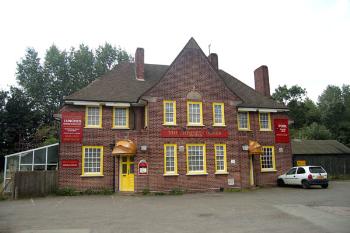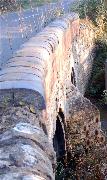Introduction

The Chimney Corner Public House September 2007
Location
Kempston Hardwick is a hamlet which fell in three civil parishes in the space of 41 years. Until 1896 it was part of the ancient, and large, parish of Kempston. In that year Kempston was divided into two civil parishes, one for the urban area and a new parish of Kempston Rural for the various hamlets around it. Kempston Hardwick was part of Kempston Rural. Then, in 1937, the new civil parish of Stewartby was formed around the brick making community which had grown up in Wootton and Kempston Rural and at that time Kempston Hardwick was transferred to the civil parish of Stewartby, where it remains.
Before Domesday
Iron Age and Romano-British finds have been made at Kempston Hardwick showing that the settlement has been occupied at least since the 1st century BC.
Name
Kempston Hardwick is not mentioned in the Domesday Book of 1086. It was first recorded in 1276 as Hardwyke, being Herdewyk by Kemeston in 1334 and Kempston Hardewik in 1485; the word Hardwick means "sheep farm".
Manors of Kempston Hardwick
The original Manor of Kempston Hardwick is first recorded in the 13th century when it was held by Nicholas de Mule and Ralph Russell. By 1281 it seems to have been held by one Robert Waleran, husband of Ralph Russell's daughter Isabel. The next time the Manor is mentioned in surviving records was in 1456 when held by Richard Boughton and remained in that family until 1542 when Edward Boughton alienated it to King Henry VIII and it became part of the Honour of Ampthill. Queen Elizabeth I granted the manor to Elizabeth Snowe in 1560 who divided it in her will two thirds to her daughter Rebecca Gery and one third to her son Edward Snowe. The whole manor was conveyed to Thomas Parsons in 1606 and he sold it in 1627 to the Governors of Christ's Hospital, London, who held it into the 20th century - all manorial incidents, courts and tenure of land being abolished under the Law of Property Act 1922.
Another Kempston Hardwick Manor was created in 1417 when the Manor of Kempston Brucebury or Draytons was divided between the two daughters of John Drayton - Kempston Hardwick going to the younger daughter Elizabeth who married first Christopher Preston, then John, Baron Wenlock, who was killed fighting for Henry VI at Tewkesbury in 1471, and his possessions were appropriated by the victorious Edward IV who gave Kempston Hardwick to Thomas Rotherham, then Bishop of Lincoln, later Archbishop of York and the manor remained in the Rotherham family until 1559 when it was sold to Thomas Hampton, who later sold it to James Feke. The sale of 1559 had been made by George Rotherham when a minor and he later pleaded to have the sale made null and void, offering compensation to Feke. However, he then sold the manor again in 1577, this time to Humphrey FitzWilliam, Lord of the Manor of Kempston Hastingsbury and it remained in that family until sold in 1619 to Sir John Wild. Before 1624 the Wilds alienated the manor to William Cater and remained in this family until 1736 when inherited by Robert Kendall, who then changed his name to Cater; the manor was divided by the three daughters of John Kendall Cater around 1778 but they combined in 1801 to sell it to William Long. Around 1850 the manor was purchased by Talbot Barnard and about 1885 sold to Walter Harter who remained Lord of the Manor into the 20th century.
Manor of Hardwick
This manor was created on the Dissolution of the Monasteries from land in the area previously owned by the Knights Hospitaller of St.John of Jerusalem who had held the land since at least 1279. In 1540 King Henry VIII gave the property to Sir Richard Longe. Two thirds of the manor eventually passed to the Earls of Bedford with the other third being owned by the Morrison family (heirs of Dorothy Morrison, née Longe) until the manor disappears from history, the last mention being in 1625.
Medieval Murder
Volume XLI of the Bedfordshire Historical Records Society publications is a translation, by R.F.Hunnisett, of medieval coroner’s rolls for the county Entry reads: "After bed-time on 17 June 1270 thieves came to the house of Robert son of Peter of Hardwick in Kempston Hardwick in the Parish of Kempston, broke its west wall and entered. Robert’s daughter Juliana saw that they were thieves and immediately went from the house, fled to the town and shouted. The neighbours came in the hue to Robert’s house and there found his daughter Christiana lying almost dead and speechless, with 20 wounds in her head, face and back and almost through the middle of her head, apparently [made] with a knife. She died about Vespers on 20 June". The account then notes that Henry Corey of Kempston was arrested and brought to Bedford gaol on suspicion for the death of Christiana daughter of Peter of Hardwick. He later escaped from gaol and had to be recaptured. He was eventually bought to trial, found guilty and hanged.
Historic Sites
 An overgrown moat lies just north of Manor Road about half way between the Chimney Corner public house and the railway station. A house that stood here in the 17th century was home to John Rush. Hardwick Bridge, a stone structure with twin arches and a brick parapet lies on Manor Road not far from Elms Farm. A "Herdwyckbrigg" is mentioned about 1430 and may be this bridge, but the modern form has been widened to three times its original width.
An overgrown moat lies just north of Manor Road about half way between the Chimney Corner public house and the railway station. A house that stood here in the 17th century was home to John Rush. Hardwick Bridge, a stone structure with twin arches and a brick parapet lies on Manor Road not far from Elms Farm. A "Herdwyckbrigg" is mentioned about 1430 and may be this bridge, but the modern form has been widened to three times its original width.